Types of Beautyberry Bushes (with Pictures) – Identification and Care Guide
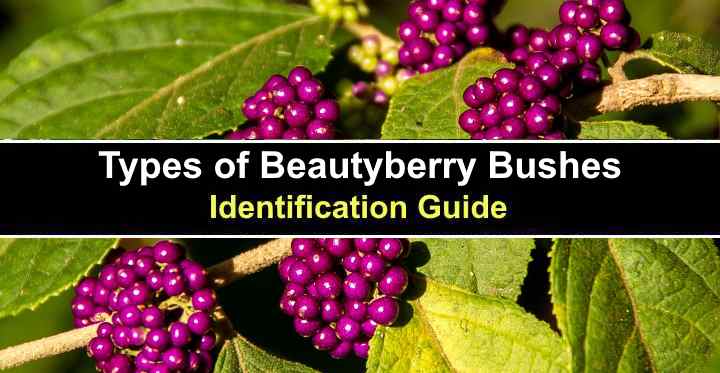
Beautyberry bushes are attractive shrubs known for their vibrant purple or magenta berries that appear in the fall. The American beautyberry (Callicarpa Americana) is the most popular type of beautyberry bush. The beautiful pink, violet, or white-flowering deciduous shrubs add color, vibrancy, and texture to front and backyards in mild to warm climate regions. Beautyberries are ideal landscaping shrubs thanks to their colorful violet fruits, which attract birds and other wildlife.
Read on to learn more about ornamental beautyberry bushes and their spectacular vibrantly-colored purple berries. In addition to identifying features of the ornamental shrubs, you will get helpful advice on growing beautyberry bushes in your front or backyard.
American Beautyberry Bush
The American beautyberry bush (Callicarpa americana) is a deciduous shrub famous for its large magenta-purple berries. The tight purple berry clusters grow in whorls, wrapping tightly around arching branches. The American beautyberry is also the largest type, reaching up to 8 ft. (2.4 m) in height.
The American beautyberry bush is native to the Southeastern United States. The eye-catching bushes thrive in states with mild winters and hot, humid summers. Therefore, beautyberry bushes are popular in Florida, Texas, South Carolina, Virginia, and Maryland. They are suitable for USDA zones 6 to 10.
The genus name Callicarpa is derived from the Greek words “kallos,” meaning beauty, and “carpos,” meaning fruit. The name aptly reflects the outstanding and visually appealing feature of the plant, which is the colorful and attractive clusters of berries produced by the species within this genus.
Asian Beautyberry
Three types of Asian beautyberries include Bodinier beautyberry (Callicarpa bodinieri), Japanese beautyberry (Callicarpa japonica), and purple beautyberry (Callicarpa dichotoma). These ornamental shrubs produce purple, lilac, mauve, and lavender-colored berries. They also have upright, arching branches that create a weeping effect. They typically don’t grow taller than 6 ft. (1.8 m) high.
Asian beautyberry bushes are native to Japan, Indochina, and China. In some areas of North America, the small fruiting shrubs can become invasive.
American Beautyberry Bush Vs. Asian Beautyberry Bush
The main difference between native beautyberry bushes and Asian varieties is size. American beautyberry bushes are larger with a more sprawling growth habit than non-native varieties. Also, Asian beautyberry bushes tend to have an upright habit with cascading, weeping branches. They are also more cold-hardy than the native species.
Can You Eat Beautyberries?
Fruit from beautyberry bushes is edible for humans and wildlife. However, the purple berries taste bitter. According to researchers from the University of Florida, you should only eat them raw in small amounts. Typically, the berries are used to make wines and jellies.
American beautyberry bushes attract various bird species to southern gardens. The berries are valuable food sources for various songbird species such as the American robin, northern mockingbird, eastern towhee, brown thrasher, and purple finch. The berries also attract opossums, raccoons, and squirrels, as well as armadillos and foxes, during the fall and early winter.
Deer generally avoid eating American beautyberry (Callicarpa americana) due to its naturally bitter taste and the compounds present in the leaves that are unpalatable to them.
Deer usually prefer not to consume American beautyberry (Callicarpa americana) berries due to their naturally bitter taste and the compounds present in the berries. While there have been occasional reports of deer consuming the berries, especially during periods of food scarcity or high deer populations, they are generally not a preferred food source for deer.
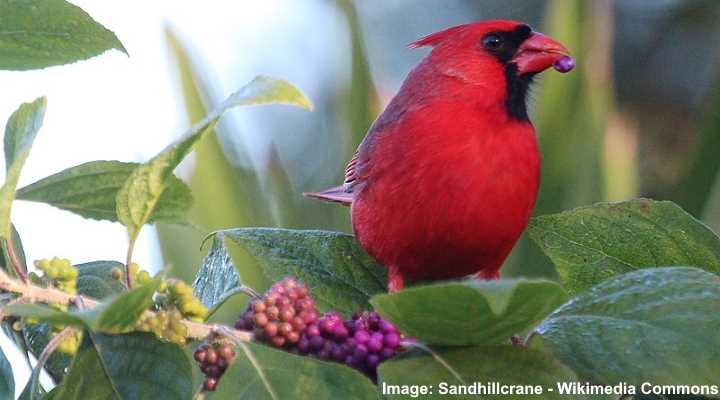
A male cardinal feeding on American beautyberry
What Do Beautyberries Taste Like?
Beautyberries have a mild, slightly astringent taste. While not typically consumed fresh due to their low sweetness, some people describe the flavor as a combination of mildly sweet and slightly tart, even spicy, like Asian five spice. The berries are ideal for making jams, jellies, or desserts.
When Can You Pick Beautyberries?
Beautyberries ripen in fall and early winter. The best time to pick them is when they are deep purple, violet, or lilac. The berries usually emerge pale and gradually darken throughout the season. By late summer, the clusters of vibrant purple berries contrast with the large leaves before the leaves turn yellow and drop.
Types of Beautyberry Bushes
Please read on to learn about the different types of beautyberry bushes that grow in North America.
American Beautyberry (Callicarpa americana)

A young American beautyberry shrub
The native American beautyberry is a deciduous shrub producing showy clusters of magenta, purple, or violet berries. Native to the southeastern US, the woody, deciduous, shade-tolerant shrub blooms in early spring with clusters of small pink, purple, or white flowers. Its green, fragrant ovate leaves grow in groups of three.
American beautyberry’s native distribution is from Virginia and Arkansas, south to Texas, and east to Florida. You can find the native shrub growing naturally at the edges of swamps, coniferous or deciduous woods, coastal woodlands, and moist thickets.
The American beautyberry bush typically grows up to 6 ft. (1.8 m) tall and wide. However, in ideal conditions, the woody shrub can grow up to 9 ft. (2.7 m) in height. The flowering shrub is characterized by its long arching stems, colorful berries, and attractive golden-yellow foliage in the fall.

Close up pictures of American beautyberry fruit. leaves and flowers
American beautyberry fruits are small, showy, purple, round, pea-like berries growing in dense clusters. The berries—technically drupes—appear from August through October, growing in whorls and encircling the stems. Each vibrantly-colored purple berry contains two to four seeds and measures 0.25” (63 mm) long and 0.19” (4.8 mm) wide.
American beautyberry leaves appear in spring. They are typically ovoid or elliptical shaped with pointed tips and serrated edges. The simple light green leaves have a fuzzy underside and measure 3.5” to 6” (90 – 150 mm) long. Beautyberry leaves turn eye-catching golden-yellow shades in the fall.
After the leaves drop, the bare branches appear laden with the characteristic purple berries that give this native shrub tremendous visual appeal in garden landscapes.
American beautyberry bush flowers are small blossoms appearing on the stems where the leaves join. Blooming in early spring and summer, the beautyberry flowers add shades of pink, white, and purple to landscapes. The flowers give way to purple berries that persist until winter.
The bark of American beautyberry is smooth, thin, and light gray to light brown in color. When the plant is young, the bark tends to be more of a light gray hue, and as it matures, it often transitions to a light brown shade.
American beautyberry is primarily grown for its ornamental appeal. Its attractive, bright purple berries form showy clusters along the stems in late summer and fall. The decorative shrub also attracts pollinators like bees and butterflies to backyard landscapes. The large shrub also performs well as a border or low hedge in southeastern gardens.
American Beautyberry is a low-maintenance plant that can tolerate various soil conditions. It can grow in moist, rich, sandy, or clay soils but prefers well-drained soil. It thrives in full sun or partial shade and is a great choice for adding color and interest to a garden or landscape.
- USDA Growing Zone: 6 to 10
- Sun Exposure: Full sun or partial shade
- Mature Size: 3 to 8 ft. (1 – 2.4 m) tall and 3 to 6 ft. (1 – 1.8 m) wide
- Bloom Time: Spring and summer
- Soil Type: Sandy, loamy, or clay, fertile soils with good drainage
- Soil pH: Neutral to slightly acidic
- Native Areas: Southeastern United States
American Beautyberry ‘Welch’s Pink’ (Callicarpa americana ‘Welch’s Pink’)
American beautyberry ‘Welch’s Pink’ is an eye-catching ornamental shrub with clusters of showy pink berries appearing in early fall. The shrub’s flowers are small clusters of white or pink blossoms blooming in spring and summer. This cultivar is more compact compared to the American beautyberry shrub. It grows 4 to 6 ft. (1.2 – 1.8 m) tall and wide.
Bodinier Beautyberry (Callicarpa bodinieri)
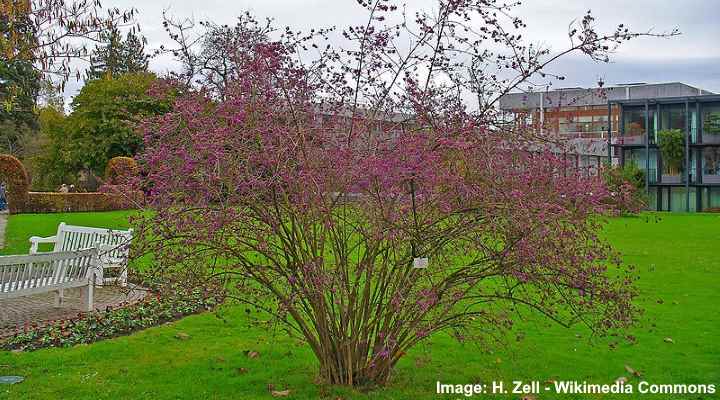
A Bodinier beautyberry (Callicarpa bodinieri) shrub
Bodinier beautyberry is a medium-sized Asian beautyberry shrub with showy clusters of vibrant purple berries. The ornamental deciduous shrub blooms in early summer with lilac flowers. These give way to shiny violet-purple berries in early fall. Also, in early fall, the shrub’s green leaves turn golden-yellow. The shrub adds vibrant colors to fall and winter landscapes.
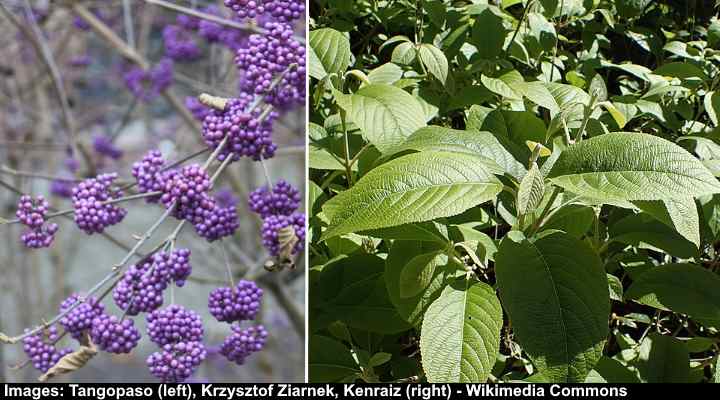
Bodinier beautyberry fruit and leaves
Bodinier beautyberry has arching branches and dense clusters of eye-catching berries resembling beads on a string. The fruiting shrub grows 4 to 6 feet (1.2 – 1.8 m) tall and wide. Its compact nature makes it ideal for borders, hedges, or as a focal point in small gardens.
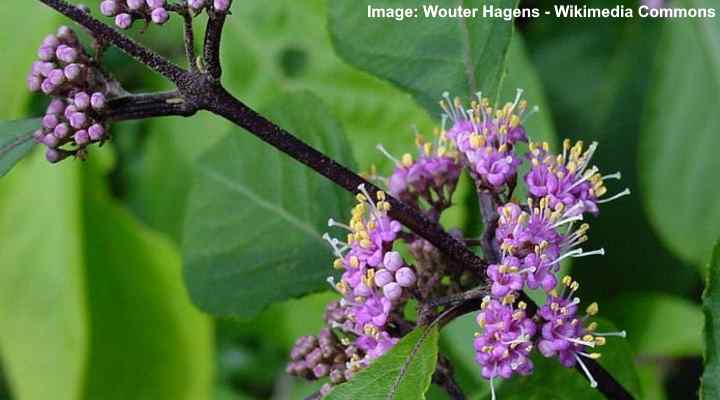
Bodinier beautyberry flowers
Bodinier beautyberry prefers well-drained soil and can tolerate full sun to partial shade. It’s also ideal for wildlife gardens, attracting birds, bees, and butterflies from early summer through winter. It’s also more cold-hardier than the American beautyberry bush.
- USDA Growing Zone: 5 to 8
- Sun Exposure: Full sun or light shade
- Mature Size: 4 to 6 ft. (1.2 – 1.8 m) tall and wide
- Bloom Time: Summer
- Soil Type: Sandy, loamy, or clay, fertile, well-drained soils
- Soil pH: Acidic, neutral, or alkaline
- Native Areas: Southern China and Indochina
Purple Beautyberry (Callicarpa dichotoma)
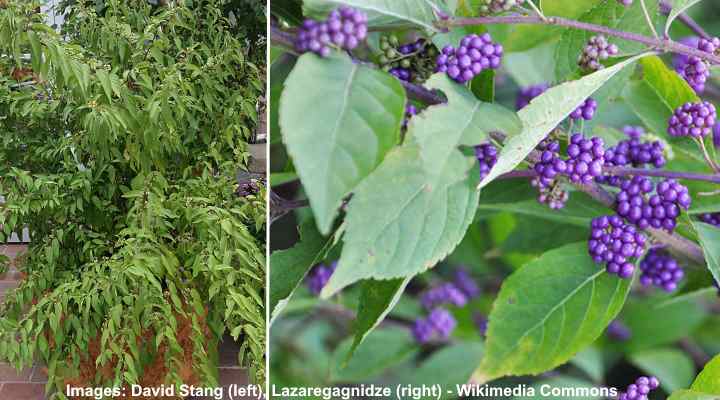
A purple beautyberry potted shrub (left) and a close up image of the fruit and leaves (right)
Purple beautyberry is a compact, rounded shrub prized for its vibrant purple berries on long arching branches. The purple berries appear in late summer, growing in clusters along weeping branches and contrasting with the golden-yellow elliptic leaves. Purple beautyberry produces pale pink to lavender flowers in late spring and summer. It’s a low-maintenance flowering shrub that grows up to 4 ft. (1.2 m) tall.
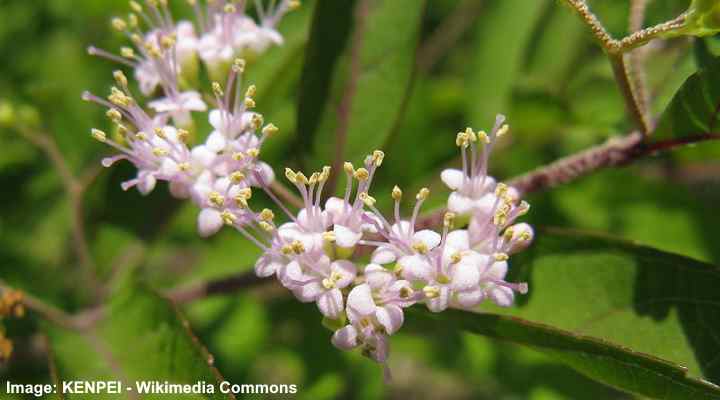
Purple Beautyberry flowers
Asian purple beautyberry shrubs add a splash of vibrancy and texture to summer and fall landscapes. The rich, deep purple berries persist on the cascading branches after the leaves have dropped. These glossy berries attract wildlife to gardens. You can grow the purple-berry shrub in foundation plantings, shrub borders, or containers.
- USDA Growing Zone: 5 to 8
- Sun Exposure: Full sun to partial shade
- Mature Size: 3 to 4 ft. (1 – 1.2 m) tall and up to 5 ft. (1.5 m) wide
- Bloom Time: Throughout summer
- Soil Needs: Tolerant of most soil conditions with good drainage
- Soil pH: Acidic to neutral soil
- Water Needs: Medium
White Beautyberry (Callicarpa dichotoma f. albifructa)
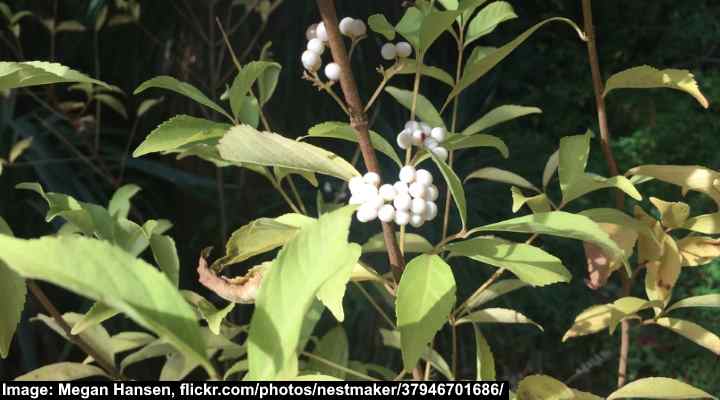
White beautyberry leaves and fruit
White beautyberry produces masses of stunning white berries in the fall. The compact, small shrub is identified by its pale pink flowers blooming in spring, attractive elliptic green leaves, and whorls of white berries winding around arching stems. The beautiful berries stand out in late fall and winter after the leaves have fallen.
White beautyberry grows up to 4 ft. (1.2 m) tall, and its compact growth makes it a good choice for smaller landscapes. You can plant the deciduous bush as a hedge, screen, foundation planting, or specimen plant. It also performs well in containers to enhance a patio or deck’s visual appeal.
- USDA Growing Zone: 5 to 5
- Sun Exposure: Full sun or partial shade
- Mature Size: 3 to 4 ft. (1 – 1.2 m) tall and 4 to 5 ft. (1.2 – 1.5 m) wide
- Soil Needs: Well-draining medium soil
- Soil pH: Acidic to neutral
- Water Needs: Medium
- Native Areas: Southern China and Indochina
Japanese Beautyberry (Callicarpa japonica)
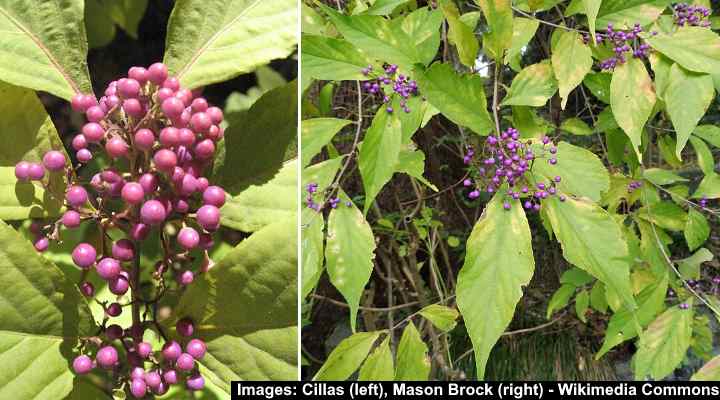
Japanese beautyberry fruit and leaves
Japanese beautyberry is a native Asian shrub prized for its clusters of vibrant purple berries on cascading branches. This Asian beautyberry shrub blooms in summer with clusters of small, pink blossoms followed by medium-green lanceolate leaves. In fall, masses of purple berries appear and persist until winter, adding a splash of unusual color to the landscape.
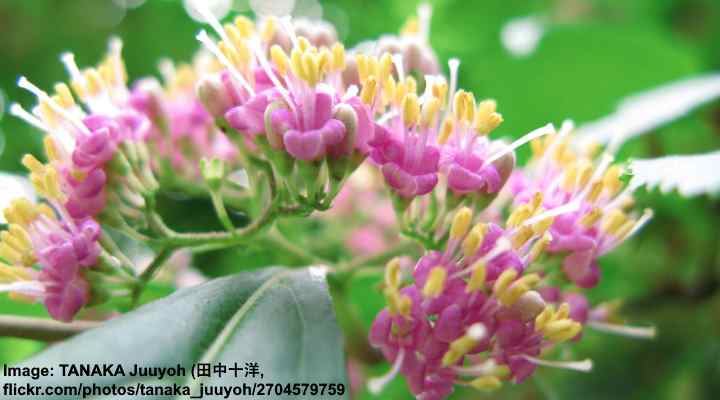
Japanese beautyberry flowers
Japanese beautyberry grows up to 6 ft. (1.8 m) tall, with the best berry production in full sun. It’s a relatively low-maintenance plant, ideal for foundation plantings, hedges, screens, or mixed shrub borders. Its ornamental appeal is enhanced by its upright, arching branches that kiss the ground at their tips.
- USDA Growing Zone: 5 to 8
- Sun Exposure: Full sun to partial shade
- Mature Size: 4 to 6 ft. (1.2 to 1.8 m) tall and wide
- Soil Needs: Well-draining soil, and it can tolerate some drought
- Soil pH: Acidic or neutral
- Water Needs: Medium
- Native Areas: Japan
How to Grow Beautyberry Bushes

Native beautyberry bushes are low-maintenance landscaping shrubs that are easy to grow. The ornamental shrubs have a medium growth rate, growing around 1 to 2 ft. (0.3 – 0.6 m) annually. They typically mature at 3 to 6 ft. (1 – 1.8 m) tall and wide, depending on the soil conditions and sun exposure.
The main care requirement to grow beautyberry bushes is to plant them in full sun or partial shade and keep the ground evenly moist. It’s also advisable to plant the bush in the appropriate growing USDA hardiness zones 6 through 10. In colder climates, you may consider a cold hardier, non-invasive Asian species.
Here is a quick guide to growing beautyberry bushes in your front or backyard.
Light for growing beautyberries
American beautyberry bushes thrive in full sunlight or partial shade. They need at least four to six hours of direct sunlight daily for optimal berry production. In the hottest growing ranges in Southern Texas and Florida, they appreciate some afternoon shade from the scorching heat. When growing in direct sunlight six or more hours a day, the shrub needs constant watering to maintain moist soil.
Too much shade causes the long stems to become leggy with sparse foliage and berries.
Soil for growing beautyberries
American beautyberry bushes thrive in well-drained soil, rich in organic matter. Although they tolerate various soil types, neutral to slightly acidic is the best. The bushy plants are tolerant to drought once established. However, the shrub will shed its leaves in dry conditions, and berry production will slow down.
The best type of soil for growing American beautyberry bushes is sandy well-drained soil. The hardy shrubs are also tolerant of salt spray. Therefore, you can plant them in coastal gardens that get constant sunshine.
Water requirements for growing beautyberries
Beautyberries are relatively drought-tolerant once established. In typical growing conditions, 1” (2.5 cm) of water weekly is ideal. However, you may need to give it more water in hot weather or if rainfall has been minimal. A layer of mulch can help to lock in moisture.
Watering newly planted bushes regularly is vital to help them establish roots. Avoid overwatering mature plants, as they can rot in waterlogged soil.
Temperature and humidity for growing beautyberries
American beautyberries are cold-hardy in USDA zones 6 through 10. The best temperature range for the berry-producing plant is 65°F to 80°F (18°C – 27°C). Some American beautyberry cultivars can withstand brief temperatures as low as 15°F (-10°C). However, it’s vital to protect the roots during freezing winters.
Beautyberry bushes are adaptable to moderate humidity levels and can tolerate some dry conditions.
Fertilizer for growing beautyberries
Beautyberry bushes typically don’t require heavy fertilization. However, they cannot thrive in nutrient-deficient soils. Therefore, you may need to apply a balanced, slow-release fertilizer in the spring. Avoid excessive nitrogen, which can promote excessive foliage growth at the expense of berries.
How to prune beautyberries
Beautyberry shrubs can produce fruit without pruning. However, late winter or early spring pruning can promote bushy growth and better berry production. To prune the shrub, cut it back to 12” (30 cm) above the ground when it is still dormant. Beautyberry blooms on new wood, and pruning encourages vigorous growth.
How to Propagate Beautyberry Bush
The easiest way to grow a new beautyberry bush is to dig up seedlings that appear around the base. You can replant them in a new location to create a hedgerow, privacy screen, or shrub border.
The other propagation method for beautyberry bushes is by taking root cuttings. Here is how to propagate beautyberry shrubs:
- Using clean pruning shears, take several 4” to 6” (10 – 15 cm) cuttings in late spring or early summer (avoid old wood). Cut just below a leaf node.
- Remove the lower leaves, leaving only a few at the top of each cutting. Dip the bottom of the cutting in a rooting hormone to help speed up the rooting of the cutting.
- Plant the cuttings in small pots filled with a moist, well-draining potting mix. Insert them about 2 inches (5 cm) deep.
- Mist the cuttings lightly with water and cover them with plastic bags or wrap to create a mini greenhouse effect.
- Place the pots in an area with indirect light.
- Check the cuttings regularly to ensure the soil stays moist but not soggy.
- Mist if needed to maintain high humidity under the plastic cover.
- Once the cuttings have well-developed roots, transplant them into larger pots or the garden in a suitable location.
Callicarpa Hybrids
In addition to the native American beautyberry (Callicarpa americana), several hybrids have been developed to offer unique and striking features. Two notable Callicarpa hybrids are Purple Pearls® (‘NCCX1’, PP#26,000) and Purple Glam™ (‘NCCX2’, PPAF). The distinct feature of these two hybrids is having beautiful purple foliage throughout the entire growing season.
Purple Pearls® (‘NCCX1’, PP#26,000) is a Callicarpa hybrid characterized by an elegant upright growing habit, delicate pink flowers, and striking violet-purple fruit. Its dark purple-black foliage remains vibrant throughout the entire growing season, with a mature height of 4 to 5 feet, suitable for USDA hardiness zones 5 to 8.
Purple Glam™ (‘NCCX2’, PPAF) is a Callicarpa hybrid that has a vigorous upright growth with charming white flowers and alluring purple-violet berries. Maintaining its attractive purple foliage throughout the season, this hybrid adds a captivating element to any garden. Similar to Purple Pearls®, it reaches a height of 4 to 5 feet and thrives in USDA zones 5 to 8.
Related articles:
